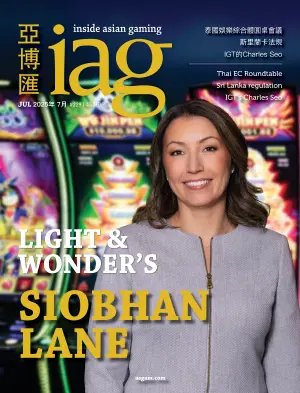In this regular feature in IAG to celebrate 18 years covering the Asian gaming and leisure industry, we look back at our cover story from exactly 10 years ago, “The Pleasure of Anticipation”, to rediscover what was making the news in April 2014!
Innovation is at the heart of gaming product design. Industry suppliers are constantly pushing the envelope when it comes to creativity, hoping to print that magic ticket that captures the world’s imagination like the now hugely popular Hold & Spin feature first coined by Aristocrat.
 Of course, developing a true “game changer” is easier said than done: the list of new game concepts that have been consigned to the annals of history is longer than the immigration line at Macau’s Border Gate on a Friday afternoon.
Of course, developing a true “game changer” is easier said than done: the list of new game concepts that have been consigned to the annals of history is longer than the immigration line at Macau’s Border Gate on a Friday afternoon.
But there are still those who dare to dream, as evidenced by the former President of Japanese supplier Sega Sammy Creation (SSC), Hisao Oguchi, who outlined some interesting ideas in the cover story of Inside Asian Gaming’s April 2024 issue.
The article, titled “The Pleasure of Anticipation”, previewed SSC’s first ever appearance at G2E Asia later that year, with Oguchi running us through his beliefs of what a modern-day gaming floor and the slot machines that populate it should look like.
Contrasting the engagement of squeeze baccarat – where the anticipation of each card is as vital to the experience as the card itself – to slot machines where players are barely interested in the spinning of the reels, Oguchi said at the time, “Although the games had variety in the past, now they all tend to be more or less the same.” [Ed’s note: Has anything changed?]
“Players are no longer interested in the process because on any game they play it’s almost the same, so they would rather just press the button and have an outcome.
“Right now, a lot of the people gambling in Macau have dreams of winning enough money to buy a home, raise their children, and so on, but I believe a casino floor should be a place where people don’t just win or lose but enjoy the process.
“It would be better if you spent $1,000 and got $2,000 worth of entertainment, not spent $1,000 trying to win $1 million but probably lost it all.”

Perhaps hoping that the then newly introduced Macau table cap might drive players towards electronic gaming instead [Ed’s note: it hasn’t], Oguchi said his vision for slot machines in the future was a more arcade-style of game incorporating elements from the video games that the SEGA in Sega Sammy is famous for.
“As China’s economy grows, Chinese people’s standards of living are changing, and we believe they will change in what they want in life,” he said. “We want to be ahead of time and already provide the Macau market with the products that Chinese and Asian people will learn to want.
“One thing I learned during my time creating pachinko and pachislot machines for Sammy is that the gaming industry must find its place in society. There are about 12,000 pachinko halls dotted around Japan – they are so connected to each neighborhood and they also function as places for people in local society to meet up and communicate. Pachinko is only able to be so widespread because the public is comfortable with it.
“That’s something the casino industry can learn from. They have to be seen not just as places for people to go and gamble, but also to have fun, to be social and to network.”






























